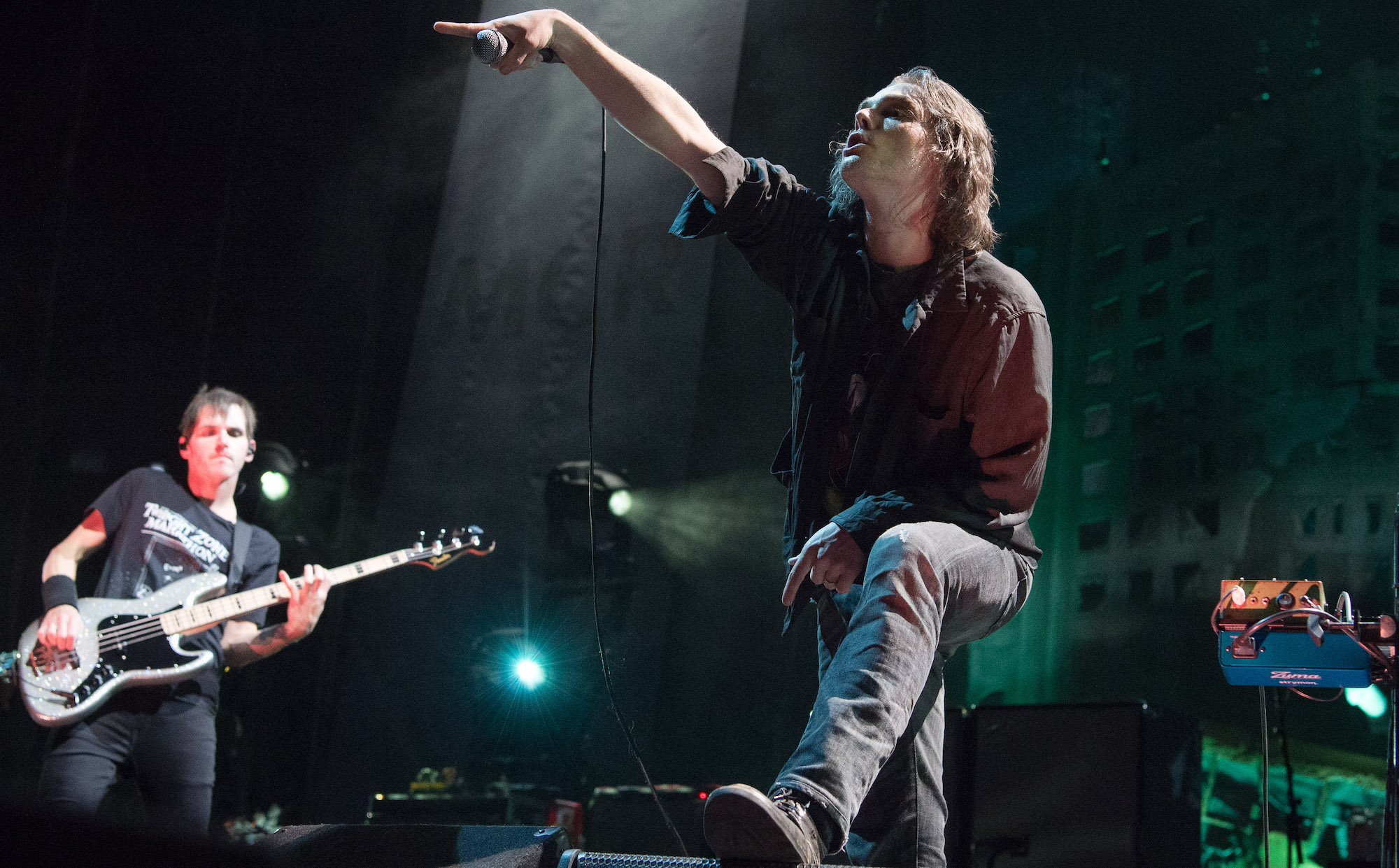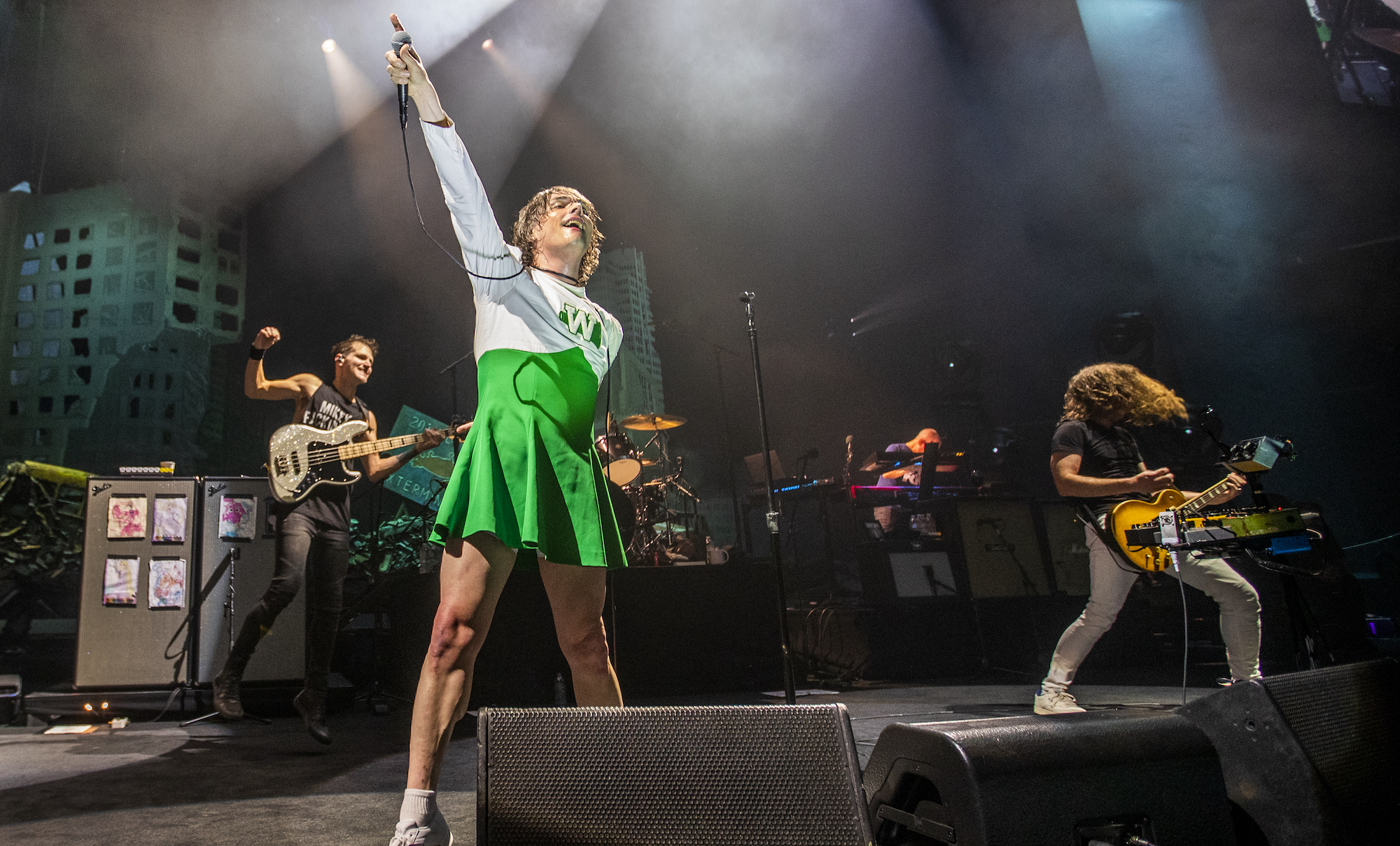Mikey Way: “I was borderline terrified a lot of the time My Chemical Romance was active. I was learning the bass in front of 20,000 people every night!”
The reunited emo kings’ low-end ranger reveals why he swapped out his signature Fender Mustang for a sparkling new signature Jazz Bass, learning bass in arenas, and how he overcame insecurity about his chops

My Chemical Romance’s reunion has seen bassist Mikey Way thrumming through the high pomp punk of The Black Parade and Three Cheers for Sweet Revenge favorites with a familiar rhythmic fortitude, but keen-eyed band obsessives have probably noticed the musician is no longer sporting the snazzy, silver-flake Squier Mustang signature model Fender built for him back in 2012.
The good news is that’s because, as Fender have just formally announced, Way has a brand-new – but just as glammy – Jazz Bass out now. There’s a good reason why Way’s made the switch: the Jazz Bass is his first love.
Though he started out on guitar, Way got the hang of a four-string in the mid ‘90s while playing a loaned-out Jazz Bass in his pre-My Chemical Romance project, Ray Gun Jones. He upgraded to a silver-finish Jazz of his own by the time MCR started touring in the early ‘00s, but a trailer mishap led to that instrument getting smashed to pieces on a highway.
Way tells Guitar World that he eventually became obsessed with the short-scale sturdiness of a Mustang bass guitar as My Chemical Romance were writing their 2010 full-length, Danger Days: The True Lives of the Fabulous Killjoys, after fooling around with a model Duff McKagan had left at North Hollywood’s Mates Rehearsal Studio. By 2012, Way had his Squier model in stores.
It was during the downtime after My Chemical Romance went on hiatus in 2013, though, that the stubbiness of his Mustang became a little hard to handle.
“I stayed away from playing bass for a little while, which is natural – I was just decompressing,” Way explains. “Then, sometime in 2014, I picked up the bass again, to get my chops back, [but] I noticed that the Mustang felt strange to me.”
After reaching out to the folks at Fender, Way got a grip on his playing by stretching out on the longer-necked Jazzes they sent him. Way’s take on the Jazz Bass is outfitted with ’70s-style single-coil pickups, and a thinline “C”-shaped maple neck the bassist says is super-speedy.
Get The Pick Newsletter
All the latest guitar news, interviews, lessons, reviews, deals and more, direct to your inbox!
The finish is silver, of course, but Way also wanted an aesthetically inkier black pickguard. The headstock, likewise, pops with its matching gloss-black finish.
Speaking with Guitar World, Way gets into the glam and grunge gods who inspired his love of a good sparkle coat, overcoming performance anxiety, and why a steady attack wins the bass race every time.
What were some of the musts when it came to designing this latest signature?
“I’ve been obsessed with the sparkle finish as far back as I can remember. Growing up in the ‘90s, the silver-flake [finish] was big in alternative music. Chris Cornell had the Gretsch Silver Jet, [Daniel Johns] from Silverchair had one – [with] the imagery the Smashing Pumpkins used, they liked sparkles.
“Ace Frehley, of course, was big into flake finishes, and as a kid, you love the larger-than-life, comic book world of Kiss. [And there’s] David Bowie – the glam rock stuff. That flake finish makes me think of so many different things, but that’s why I love it so much.
“I remember being younger and going into stores and seeing a flake finish and being like, 'Oh my god, that’s an expensive [looking guitar] – I can’t afford that, let alone play it.' It was almost intimidating.”
One aesthetic difference between your Mustang model and this Jazz is that you didn’t throw a racing stripe on this one.
“I thought about bringing it back and keeping the continuity. Maybe somewhere down the line we’ll throw a racing stripe on this. The thing with [seeing a] racing stripe was always like, 'This player is a badass!'”
Is there a psychology behind removing the racing stripe, then?
“The psychology behind it is that I forgot about it. When My Chemical Romance was talking about doing reunion shows [in 2019], I’d contacted Michael Schulz from Fender and was like, 'Is it OK if I make a new bass for this [next] era of My Chemical Romance?' I wanted to take my past and bring it to the future – taking my Mustang and melding it with the Jazz Basses that I loved so much.
“I tried to have my cake and eat it, too. I wanted the thinner neck, and I wanted the silver-flake, but I wanted it on a Jazz Bass. They knocked it out of the park immediately.”
Getting back to how you used to admire those silver-flake guitars in the shops, you actually started out as a guitarist, right?
“So, the story goes that my brother [My Chemical Romance vocalist Gerard Way] had a Sears acoustic guitar when he was 10 years old. We would take a shoelace and make a strap, and we would stand on the couch pretending we were in Iron Maiden. And then it got real around ’93-’94, which lines up with the rise of alternative music. You started to see people that looked exactly like you, and they were playing guitar. They were playing Fender Strats!
“My brother got a Mexican Stratocaster, Lake Placid Blue. I found it not too long ago, and Michael from Fender hot-rodded it. That’s how I cut my teeth – that Mexican Stratocaster [was] my first foray into really trying to learn how to play guitar. I would watch bootlegs of concerts, and watch [guitarists’] hands and fingers – Thom Yorke, Billy Corgan, Noel Gallagher, Jonny Greenwood. I would watch what they were doing. It all started from that.
“Bass came out of necessity, twice. Me and my brother had a band called Ray Gun Jones, I guess in ’95-’96. It was kind of Weezer-ish, or us doing a surf-punk thing [with] a little bit of pre-mid-west emo. At the time we were really into Weezer, Jawbreaker, Promise Ring, Smashing Pumpkins, Nirvana, Sunny Day Real Estate.
“[Ray Gun Jones] needed a bass player, so my brother was like 'Hey, do you want to play bass for my band?' I was already a huge fan – I’d always tag along to practices. The ex-bass player let me borrow their bass. We had 4-5 songs, and I got the rudimentary from that. In that era, everyone was like, 'I want to be a guitar hero,' but I realized I had a natural knack for [bass]. I picked it up right away.
“Then, with My Chemical Romance, it was the same thing. My brother was like, 'We need a bass player,' and I was like, 'Well, this is familiar' [laughs]. 'Here’s the demo; learn these songs.' They weren’t terribly difficult.”

Was that bass you had borrowed a Fender Jazz?
“Yup, I’ve only ever played Fender. I’ve tried tons of other basses from other companies, but it always feels alien to me.”
You mentioned studying the playing of Thom Yorke or Billy Corgan through those bootleg vids. Were there any bassists that you treated similarly, to understand the mechanics of bass?
“Matt Sharp from Weezer. I tried to ape him in the beginning, but my attack sounds vaguely reminiscent of a Smashing Pumpkins recording. I would learn Siamese Dream and Melon Collie and the Infinite Sadness, and the Blue Album [the band’s 1994 self-titled debut] by Weezer. Those were the three albums that I put the most time into learning. That’s in my DNA.”
How about from a hyper-local perspective. If My Chemical Romance started out playing New Jersey basements and VFW halls, where there any bassists from that scene that inspired you, or that you appreciated?
“Yes! We shared a rehearsal space with this band called Pencey Prep – that was [MCR guitarist] Frank Iero’s original band. John McGuire was their bassist, and he let me borrow his equipment all the time. He taught me fundamentals, and gave me pointers – he taught me a whole heck of a lot.
“I always respected Tim Payne from Thursday, I loved his attack and stage presence. And when I’d watch Gabe Saporta from Midtown, I thought 'This dude is the coolest guy in the room.' He’s got this calm, cool, and collected [presence] that you can’t fake or learn. And then Eben D’amico from Saves the Day – brilliant!
“I would try to learn Saves the Day basslines. They were pretty complex [compared to] what most bands were doing in that scene. Most bands in the post-hardcore scene had simplistic basslines, but Saves the Day did not.
“There’s also Ray Toro, the guitar player of My Chemical Romance. Not only is he truly gifted at guitar, but he’s truly gifted at bass and drums – Ray can do everything. He was instrumental, early on, with showing me the ropes. Ray gave me lessons when I was a novice. I can’t thank him enough for that.”

What kind of pointers was he giving you?
“He showed me proper fretting, or [how to maintain] a steady attack. I got a really great compliment from our front-of-house guy, Jay Rigby. He told me that I’m one of the very few bass players that he doesn’t have to go in and tweak the volume [for]. 'You’re steady, throughout.' I think that’s something that Ray Toro instilled in me: the consistency of attack.
“It’s funny thinking about it, but I was such a novice going into My Chemical Romance that I would bring myself into an anxiety-ridden state of, 'Oh my god, we have a show tonight; I have to start practicing right now.' I would be practicing four to five hours before we played – I’d play the set [in the green room], and then I’d play it again. Other bands would be like, 'What are you doing?' I was so neurotic at that point, because there were so many people around me that were beyond gifted.
“I got pushed into the deep end; you’ve got no choice but to figure it out. Ray and Frank are so gifted that I had to keep up. I didn’t want to ever do the music a disservice.
“That brings me back to the simplicity of the early My Chem basslines. The first album [2002’s I Brought You Bullets, You Brought Me Your Love] was me learning the bass, and somehow [producer] John Naclerio recorded me and said, 'You did a great job,' which I did not expect.
“I thought I was going to go in there and they were going to have to do some studio magic, or someone would come in and play [my] part. I thought of the worst-case scenario, but I went in and did it. I played the bass seriously [enough] by that point.”
What are you generally looking for in a My Chemical Romance bassline?
“What makes it for me is if I do a fill, I’ll only do it once. If you listen to [the band's 2022 comeback single] The Foundations of Decay, any fill on there I only do one time. What’s interesting about The Foundations of Decay is that it’s very loose and run-and-gun. We went in and punched things in for timing, which everyone in the world does, but the meat of that is first-or-second take. Which brings me to someone else who was very instrumental to my bass playing: Doug McKean.
“He’s no longer with us, unfortunately, but he was our engineer from The Black Parade [until his passing in 2022]. He was always a huge cheerleader for me – he instilled confidence in me. He was always good at getting a killer performance out of me.”
What are some of the biggest My Chemical Romance bass moments for you?
“I’ll say that fill in on Foundations. No-one saw that coming.”
There’s a YouTube video out there of someone playing their favorite Mikey Way basslines, some while using your signature Squier Mustang, but one standout in particular is The Black Parade’s The Sharpest Lives.
“What’s funny is Sharpest Lives has a bass solo, and I was terrified of it. I had performance anxiety [through] the 12 years before we broke up – I don’t have it anymore. Somehow when the band got back together, a switch in my brain [got] flipped. [But] while My Chem was active, I was borderline terrified a lot of the time.
“I’m playing with people far above my skill level, I’m playing [on bills] with bands where their bass players are way better than me, [and] our shows were getting massive. We were playing arenas! So not only are you learning the bass, but you’re learning the bass in front of 20,000 people every night. It made me tweak a little, but I think it shaped me into what I became.
“That solo gave me anxiety. It was when we were playing the biggest venues of our career, and it would break for the solo [Way starts singing his ascending bass lick]. I practiced it relentlessly, then it [became] second nature. Later on, it [became my favorite part of the show.”

You’re already playing the Jazz signature in your live show, yeah?
“It’s what I use for the live show. Basically, Fender built [it] for the reunion, and then we made a couple tweaks for when we release it.”
Was there a learning curve at all towards transferring My Chemical Romance songs you’d written on a Mustang onto the Jazz?
“There was Planetary (GO!), a song off Danger Days. I’d guess you’d say the whole thing is a disco beat. It’s dance-y – [Mikey starts singing an octave-popping bassline], I do that for the entirety of the song. I was very happy that I only had to do that on a Mustang, initially [because of the shorter scale]. But going back to what I said, [after] I took a little break, [I] went back to a Jazz Bass.
“I missed the room, or the way my hand went up and down the neck. I wanted to go back to that, so I jumped back in and felt right at home again.”
How many Jazzes are you bringing on the road?
“I bring two basses out, [but] I stopped even switching [during the set]. This is a testament to Fender craftsmanship – that thing stays in tune. It’s got the four-saddle bridge, and it stays in tune so well. I’m a little neurotic so I’ll tune every few songs, but if I went five to six songs you probably wouldn’t even notice.”
What does it mean to you to now have a fully-formed Fender signature model – as opposed to the Squier – and with the body shape you began your career with?
“It’s really a dream come true. It’s funny, in 2002-3 we started touring across the country. I had a Mexican Jazz Bass, but [the band] were like, 'You have to use something with better electronics; better wood. Step it up!' So, I went into the Guitar Center on Route 46 in New Jersey, and at the time Fender had released a special Guitar Center edition that was silver-flake.
“It always bugged me that the pickguard was white – it threw me off, aesthetically, and I was like, 'I’m going to change that pickguard one day.' So, I got that, and I was using that for a while.
“We were out with [Boston emo quartet] Piebald – it was one of our first cross-country tours ever – and one night someone forgot to close the trailer door. We’re driving on the highway, and half the contents spilled out – unfortunately, my bass was a casualty of that.
“But Frank Iero, and his heart of gold, jumped out on the highway in the middle of the night and tried to recover [the bass]. He was like, 'Maybe we can fix it!' I’ll never forget him doing that. He got a chunk of it – it’s in one of our storage units.”
- For more information on the Limited Edition Mikey Way Jazz Bass, head to Fender.com.
Gregory Adams is a Vancouver-based arts reporter. From metal legends to emerging pop icons to the best of the basement circuit, he’s interviewed musicians across countless genres for nearly two decades, most recently with Guitar World, Bass Player, Revolver, and more – as well as through his independent newsletter, Gut Feeling. This all still blows his mind. He’s a guitar player, generally bouncing hardcore riffs off his ’52 Tele reissue and a dinged-up SG.
“I asked him to get me four bass strings because I only had a $29 guitar from Sears”: Bootsy Collins is one of the all-time bass greats, but he started out on guitar. Here’s the sole reason why he switched
“I got that bass for $50 off this coke dealer. I don’t know what Jaco did to it, but he totally messed up the insides!” How Cro-Mags’ Harley Flanagan went from buying a Jaco Pastorius bass on the street to fronting one of hardcore’s most influential bands















